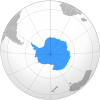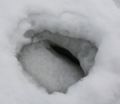Trisha's mini science experiments in Antarctica, with icicles, balloons and more...
Contents
Icicle sculptures with frozen sea ice at New Harbour
I experimented with sticking icicles together, using my own saliva and sometimes trying fresh water. It worked best when temperatures were below minus10oC and the saliva definitely froze to hold the ice in place. Fresh water worked also but wasn't quite as strong. Here are a few photos of the results of this fun experimenting: (especially for you Room 1 at Warrington School!!)
Balloon experiments in the Antarctic cold, dry environment
Here are a few experiments with balloons... For the first one I inflated a balloon with air and hung it outside here at New Harbour. The length of the balloon was 51cm and temperature outside -9oC. The next day the balloon had shrunk to 46cm (a 5cm shrinkage) with the temperature outside being -7oC. Cold air takes up less space than warm air because the air molecules are moving slower and are closer together. When I touched the balloon it immediately split. The balloon had become so brittle because of the cold that it wasn't strong enough to remain intact!
The second balloon experiment was with water filled balloons frozen outside (it took overnight to freeze right through) and then turned into a balloon sculpture! The balloon was still quite strong when I tried to remove it from the ice balloon. Maybe this is because it was wet from the water and the previous balloon filled with air was super dry and cold , so it became brittle.
Experiment with salt on sea ice and snow
This experiment was simply to see what would happen when I poured salt onto sea ice and snow. We know that salty sea water freezes at a lower temperature than fresh water ( -2C rather than OC), so what do you predict will happen when I pour more salt onto the sea ice and onto the fresh water snow??
I started the experiment by clearing a plot of sea ice (made of seawater) and finding a smooth plot of fresh snow (made of fresh water!). I then poured an equal amount of salt onto each plot and observed what happened over the next 5 minutes, 1 day and 2 day intervals.
Why do you think the sea ice and snow got a deep hole after putting salt on them?
Can you notice any difference between the sea ice and snow plots?
Explanation: The increased salt content on the ice causes the freezing point to decrease, making the hole in the ice and snow. This actually happens in the sea ice. The salt in the sea ice when it is first frozen, starts to 'leach' out, moving down through the ice in tiny brine columns (salty water columns). So after a while the sea ice is not so salty at all. In fact if we would need to, we could use the sea ice for drinking water. But if you would have to drink straight sea water from the open sea, as your drinking water, you would die!
Experiment with hot and cold water outside in the freezing conditions of Antarctica
What do you think will freeze fastest: a cup of cold water or a cup of hot water? For some reason, many people think that a cup of hot water will freeze faster. The water molecules in hot water are definitely moving faster and are further apart, and the water molecules in ice are also held further apart than in cold water (that's why ice takes up more space than cold water)... so maybe the hot water will turn to the ice quicker?...
Well, when I tried it down here at New Harbour, the cold water definitely froze before the hot water, BUT the hot water did drop in temperature quicker (however it had a much longer drop to go to 0 degrees Celcius, to freeze.
There was an interesting thing happening on the cup of hot water though. The steam turned to ice crystals on the side of the cup very quickly, way before the hot water turned to ice. But by the time I took the photo of the hot and cold water cups, the crystals had disappeared! What do you think would have been happening here?
Frozen Bubbles
Late one night when I was about to go to bed, I realised the temperature had plumeted to perhaps minus 15C ... SO I ventured outside with my bubble mixture... AND... managed to get some frozen bubbles! I had frozen hands and couldn't managed the camera (or video) with bubble mix, numb fingers and blower all at the same time!!! (needless to say, everyone else was already tucked up in bed!!). So I shall try to explain them to you: The bubbles held their shape for a long time then shrivelled up slowly and upon shrivelling turned a murky white color. They then continued to role along the snow covered ground in this blob of frozen dishwash liquid blob! When I tried to catch one it just splat over my glove in these murky white strands of frozen dishwash liquid! It's the craziest bubble blowing I've ever done. By the way, I had to stop when the bubble mixture in my pottle was getting too thick and frozen to blow bubbles from !! Haha, must have been time for that nice warm sleeping bag anyway :)






















